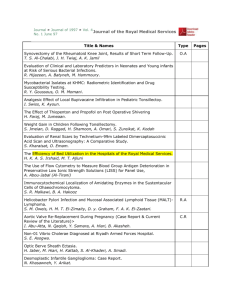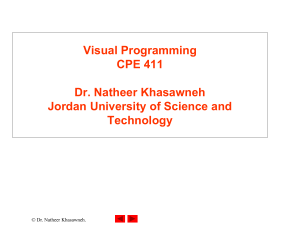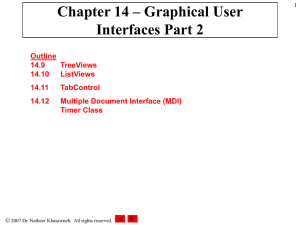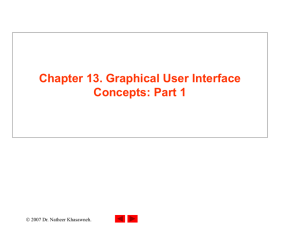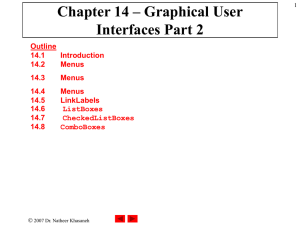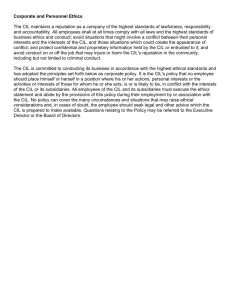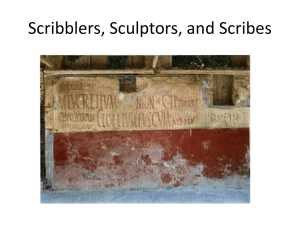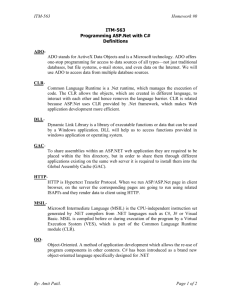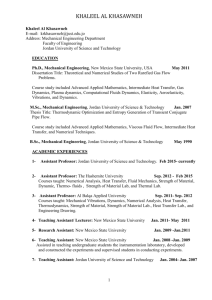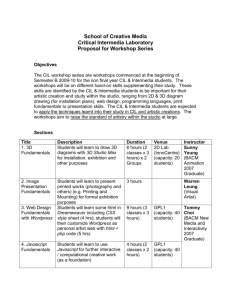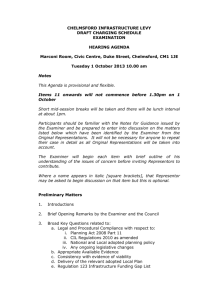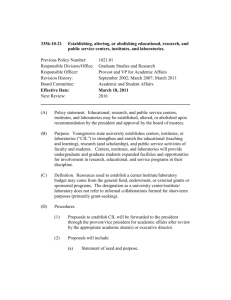Lec02_Review
advertisement
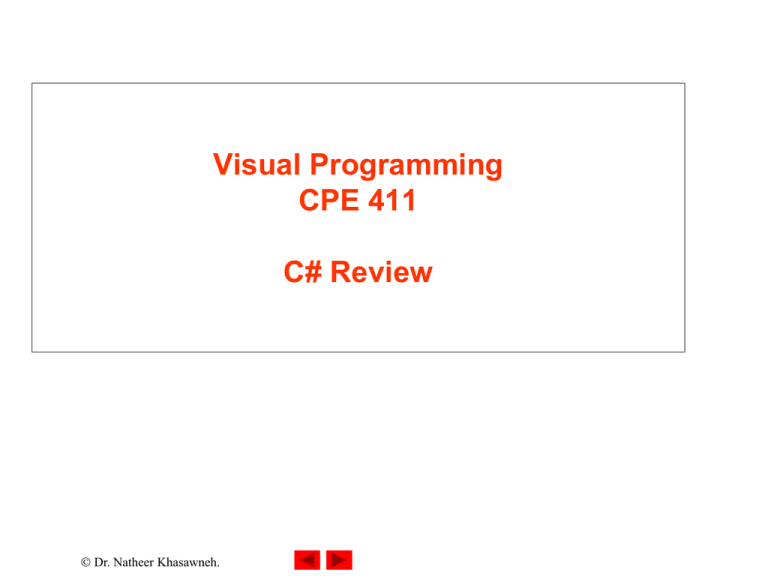
Visual Programming
CPE 411
C# Review
Dr. Natheer Khasawneh.
.NET Framework
•
•
•
•
•
Common Intermediate Language (CIL)
Common Language Runtime (CLR)
Just-In-Time (JIT) Compiler
Common Language Specification
Framework Class Library (FCL)
Dr. Natheer Khasawneh.
Compiler
• Software that translate high-level language (C++,
Java, C#, etc) to machine language.
• Compiler X can covert high-level Y to machine
language Z.
Dr. Natheer Khasawneh.
C++ Code
C++
Complier for
Intel
Intel x86 machine
code
Dr. Natheer Khasawneh.
Complier Example
C++
Complier for
Motorola
Motorola 68000
machine code
Problem
• A big problem facing developers is the many
different types of processors that run code.
• Windows, Macintosh, and Unix machines use a
wide variety of hardware, as do personal digital
assistants, cell phones, large computers, and other
platforms.
• One way to make a program work on each of these
devices is to translate the program to the native
instruction
Dr. Natheer Khasawneh.
•So if we have 3 programming languages and 3
devices, how many compilers do we need?
•So, how they solved this?!
Dr. Natheer Khasawneh.
Two Steps Compilation Process
• Compilation is done in two steps:
– At compile time: compile each language (C#, C++, etc) to
Common Intermediate Language (CIL)
– At runtime: Common Language Runtime (CLR) uses a Just
In Time (JIT) compiler to compile the CIL code to the native
code for the device used
Compile
Time
Dr. Natheer Khasawneh.
Run
Time
Common Intermediate Language (CIL)
• Much like the native languages of devices.
• CIL was originally known as Microsoft Intermediate
Language (MSIL).
• CIL is a CPU- and platform-independent instruction set.
• It can be executed in any environment supporting the .NET
framework
• Hello World Example in CIL
Dr. Natheer Khasawneh.
Common Language Runtime (CLR)
• The Common Language Runtime (CLR) manages
the execution of code.
• CLR uses Just-In-Time (JIT) compiler to compile
the CIL code to the native code for device used.
• Through the runtime compilation process CIL
code is verified for safety during runtime,
providing better security and reliability than
natively compiled binaries.
• Native image generator compilation (NGEN) can
be used to produces a native binary image for the a
specific environment. What is the point?
Dr. Natheer Khasawneh.
.NET Framework
Visual Studio .NET
C++
C#
VB
Perl
…
J#
Common Language Specification
Web Forms Web Services
Mobile Internet Toolkit
Windows
Forms
ADO .NET and XML
.NET Framework (Base Class Library)
Common Language Runtime
Operating System
Dr. Natheer Khasawneh.
Visual Studio .NET
ASP .NET
Compilation Process
• So if we have 3 programming languages and 3
devices, how many compilers do we need?
Source
code
VB
VB Compiler
CIL
NGEN
Native
code
C#
C# Compiler
CIL
C++
C++ Compiler
Executes
under the
management
of a virtual
machine.
CIL
Common Language Runtime JIT Compiler
Managed
Code
CLR Services
Dr. Natheer Khasawneh.
Managed
CLR
Code
Managed
Code
Operating System Services
Unmanaged
Code
Dr. Natheer Khasawneh.
CIL
• C# compiler translates C# source code into CIL
C# source
Calc c = new Calc();
int sum = c.Add(2, 4);
C# compiler
CIL
.locals init ([0] class Calc c, [1] int32 sum)
newobj instance void Calc::.ctor()
stloc.0 // c = ptr to new object
ldloc.0
ldc.i4.2 // pass second arg
ldc.i4.4 // pass first arg
callvirt instance int32 Calc::Add(int32,int32)
stloc.1 // sum = retval
Dr. Natheer Khasawneh.
Platform and Language Independent
• What we have described so far will lead us to
Platform independent environment. How?
• Can we use compiled classes written in X
language in a program written in Y language?
• VB.NET + C#.NET code
Dr. Natheer Khasawneh.
Language interoperability
• All .NET languages can interoperate
C# calling
VB.NET
class Hello
{
static void Main()
{
System.Console.WriteLine(Greeting.Message());
}
}
Class Greeting
Shared Function Message() As String
Return "hello"
End Function
End Class
Dr. Natheer Khasawneh.
Execution engine
• Common Language Runtime (CLR) is the
execution engine
– loads IL
– compiles IL
– executes resulting machine code
CLR
IL
Dr. Natheer Khasawneh.
Runtime
compiler
machine code
Execute
JIT runtime compile
• CIL is compiled into machine code at runtime by the CLR
– compiles methods as needed
– called just in time (JIT) compile
• JIT compilation model:
– first time method is called the IL is compiled and optimized
– compiled machine code is cached in transient memory
– cached copy used for subsequent calls
Cache
machine code for F()
CIL code
F()
G()
H()
Dr. Natheer Khasawneh.
JIT runtime
compiler
Execute
NGEN install time compile
• Can compile CIL into machine code when app
installed
– use native image generator ngen.exe
– can speed startup time since code pre-compiled
– but cannot do as many optimizations
– original IL must still be available for type informationCLR
IL
ngen
Dr. Natheer Khasawneh.
machine code
native
image
cache
Execute
Language variability
• Not all .NET languages have exactly the same capabilities
– differ in small but important ways
C#
signed integer
unsigned integer
class Hello
{
static void Main()
{
int i;
uint u;
}
}
VB.NET
signed integer only
Dr. Natheer Khasawneh.
Class Greeting
Shared Sub Main()
Dim i as Integer
End Sub
End Class
Common Language Specification
• Common Language Specification (CLS) defines
type subset
– required to be supported by all .NET languages
– limiting code to CLS maximizes language interoperability
– code limited to CLS called CLS compliant
not CLS compliant
to use uint in public
interface of public class
Dr. Natheer Khasawneh.
public class Calculator
{
public uint Add(uint a, uint b)
{
return a + b;
}
}
Framework Class Library (FCL)
• Namespace: A collection of classes and their
methods. Example: System.Windows. Forms
• The .NET Framework class library is a library of
classes, interfaces, and value types that are
included in the Windows Software Development
Kit (SDK).
• Namespaces are stored in DLL files called
assemblies
• .NET applications must have “references” to these
DLLs so that their code can be linked in
• Included in a C# program with the using keyword
– If not included, you must give the fully qualified name of
any class method or property you use
• System.Windows.Forms.MessageBox.Show(…)
Dr. Natheer Khasawneh.
Some Important .Net Namespaces in FCL
•
•
•
•
•
•
•
•
•
•
•
•
System
Core data/auxiliary classes
System.Collections
Resizable arrays + other containers
System.Data ADO.NET
database access classes
System.Drawing Graphical
Output classes (GDI+)
System.IO
Classes for file/stream I/O
System.Net
Classes to wrap network protocols
System.Threading
Classes to create/manage threads
System.Web
HTTP support classes
System.Web.Services
Classes for writing web services
System.Web.UI
Core classes used by ASP.NET
System.Windows.Forms
Classes for Windows GUI apps
See online help on ‘Class Library’ or use MSDN (3CDs)
Dr. Natheer Khasawneh.
Required CLR
• CLR and .NET Framework required to run .NET
app
– will be incorporated into Windows and service packs
– developers install as part of .NET Framework SDK
– users can run dotnetredist.exe
Dr. Natheer Khasawneh.
Introduction to C#
• A new component & object oriented language
– Emphasis on the use of classes
• Power of C plus ease of use of Visual Basic
• Combines the best aspects of C++ and Java
– Conceptually simpler and more clear than C++
– More structured than Visual Basic
– More powerful than Java
• Syntax very similar to C/C++
– No header files
• Managed pointers only
– “Almost no pointers” “almost no bugs”
Dr. Natheer Khasawneh.
C# Classes
•
Can contain:
–
–
–
“Fields”: Data members (like C++ variables)
“Methods”: Code members (like C++ functions)
“Properties”: In-between members that expose data (get , set)
Dr. Natheer Khasawneh.
Properties
•
•
•
To user program they look like data fields
Within the class they look like code methods
Often provide controlled access to private data fields
–
–
Validity checks can be performed
Values can be obtained or set after validity checks
•
•
•
Properties use Accessor methods get()and set()
get() to retrieve the value of a data field
set() to change the value of a data field
Dr. Natheer Khasawneh.
Example: Square Class
public class Square
{
private int side_length; // A Field
public int Side_length // A Property
{
get { return side_length; }
set
csc /t:library Square.cs
{
side_length = value;
}
}
public int area() // A Method
{
return (side_length * side_length);
}
public Square(int side) // The Constructor method
{
side_length = side;
}
}
Dr. Natheer Khasawneh.
class SquareTest Instantiating and Using the Square Class
{
static void Main()
{
string mySide = System.Console.ReadLine();
int mySideInt = int.Parse(mySide);
Square sq = new Square(mySideInt);
// Construct a Square object called sq
// of side_length = 10
// Instantiates the object and invokes
// the class constructor
csc /r:Square.dll SquareTest.cs
int x = sq.Side_length;
// Retrieve object’s Side_Length Property
sq.Side_length = 15;
// Change object’s Side_length Property
int sq_area = sq.area();
// Define an integer variable and use
// the class area() method to compute
// the area of the square
System.Console.WriteLine("Area= " + sq_area.ToString());
// Display result in a Console
// Note use of ToString() method
// to con vert an integer to a string.
// WriteLine() is a static method of Console
// class
}
Dr. Natheer Khasawneh.
}
Summary
• Understand the concept behind the .NET Framework
(CIL, CLR, JIT, FCL, NGEN, Managed Code, CLS)
• Create classes. Compile classes into assemblies
• Use classes.
• Object-Oriented concepts (abstraction, inheritance,
and polymorphism)
• Work hard!
Dr. Natheer Khasawneh.
